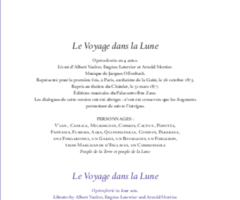Le Voyage dans la Lune

Opéra-féérie in four acts and twenty-three scenes premiered at the Théâtre de la Gaîté on 26 October 1875 then revived at the Théâtre du Châtelet on 31 March 1877.
The libretto by Albert Vanloo, Eugène Leterrier and Arnold Mortier drew its inspiration from Jules Verne’s works, in particular De la Terre à la Lune (From the Earth to the Moon) and Au centre de la Terre (Journey to the Centre of the Earth). Verne actually complained to his publisher about the numerous similarities between the storyline of Voyage dans la Lune and his own works. The composer and librettists of this opera wanted to capitalise on the popularity of this writer’s novels, which had given rise to some very well-received adaptations, and on the Parisian liking for the féérie genre, which hinged in particular on impressive stage effects. The highlight in this respect of Le Voyage dans la Lune was probably the appearance of a mehari camel on stage, borrowed from the Jardin d’Acclimatation. However, spectators also found the stage sets by painters Cornil, Fromont and Cheret very impressive, with their realistic replicas of the Paris Observatory, a blast furnace and an erupting volcano, and their representations of imaginary places such as a lunar landscape, a glass palace and mother-of-pearl tunnels. Last but not least, large choral masses and ballets lent this work all the possible brio of a French Second Empire opera production. As well as the stage effects, the success of this imaginative opera was secured by the comic yet poetic content of the libretto—which portrays the meeting between inhabitants of the Earth and a disillusioned Orwellian society—and the quality of Offenbach’s melodies. After its Paris premiere, the work was staged in London and in Vienna, in 1876.
Scientific publications
Articles
Shooting for the Moon with Offenbach
Articles
Offenbach and the ‘féerie’
Publication



















